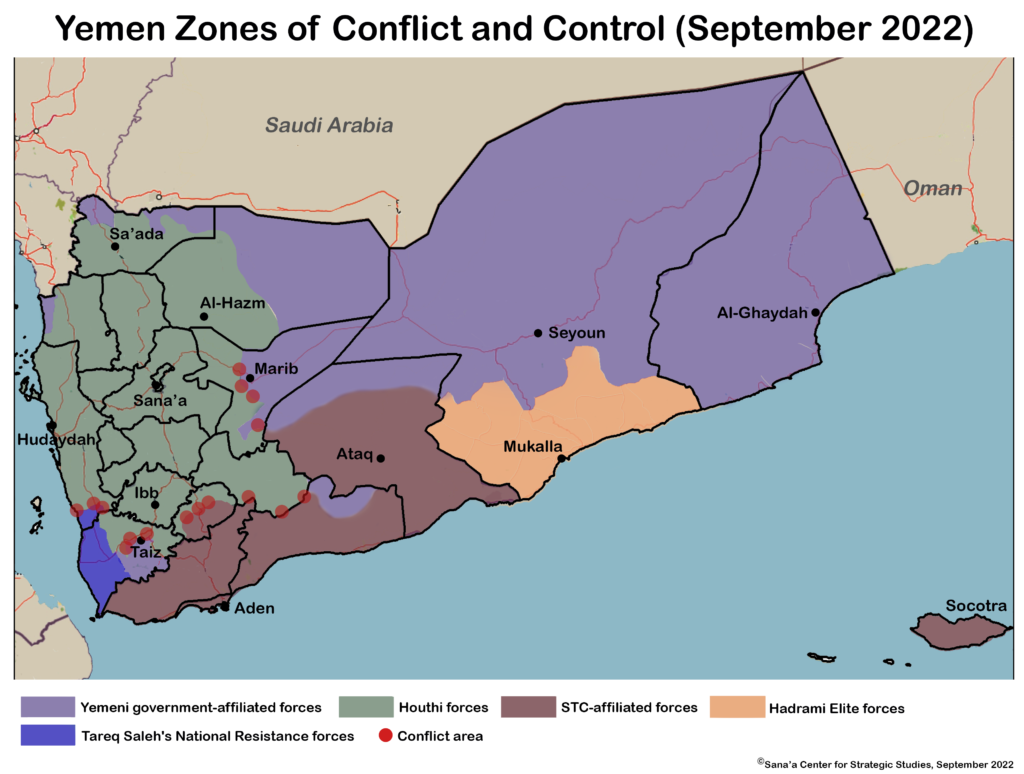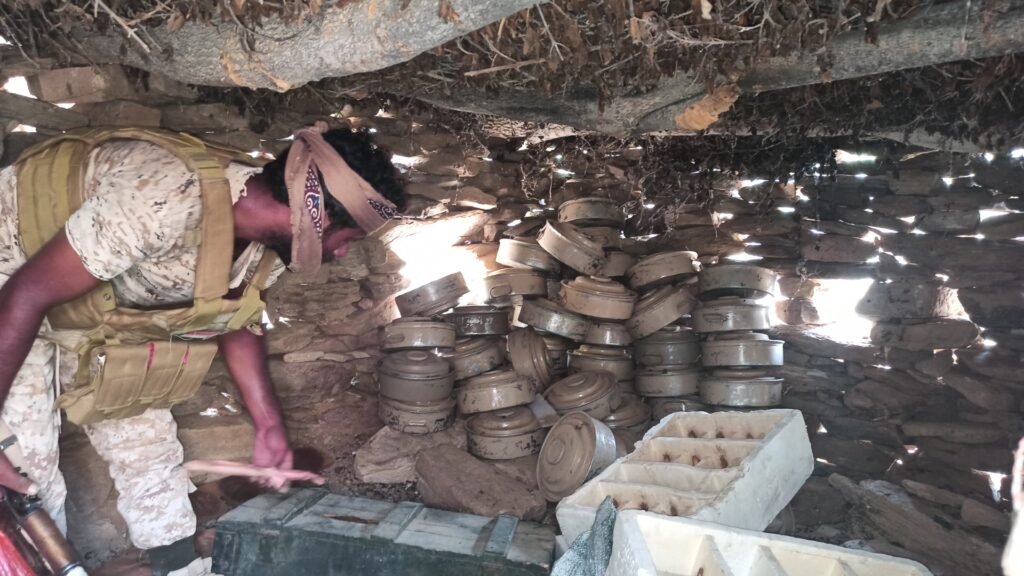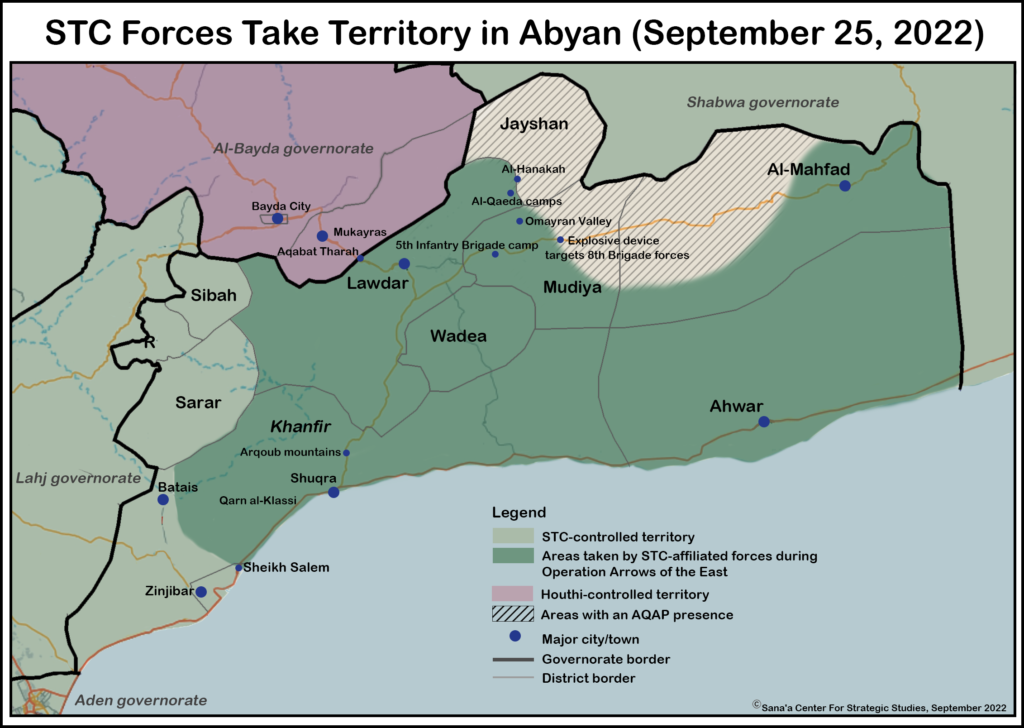The military situation between government and Houthi forces remained largely stable in September, with no major military operations undertaken by either side despite ongoing low-level clashes, mostly in Marib, Taiz, Hudaydah, Al-Bayda, and Al-Dhalea governorates. An uptick in Houthi attacks was reported along these fronts in the days following the expiration of the truce on October 2, but government military officials tended to characterize these attacks as conforming to existing dynamics. As of October 6, no large-scale military offensive had been reported.
Behind the frontlines, low-level conflict continued between various government-aligned units, with Islah-aligned and UAE-backed forces observing an uneasy detente along the Shabwa-Hadramawt border and along the international highway linking Al-Abr to Shabwa. Islah-aligned forces remain concerned that the UAE-backed Giants Brigades will attempt to advance toward the Al-Abr border crossing with Saudi Arabia en route to Islah-controlled Wadi Hadramawt. In Jawf Governorate, the continued house arrest of Islah-aligned government political and military officials may have provoked an attack on border guards that resulted in the death of a Saudi officer.
In southern Yemen, STC-aligned forces continued their nominally counter-terrorist campaign against Al-Qaeda in the Arabian Peninsula (AQAP) in Abyan and Shabwa governorates. In Abyan, Operation Arrows of the East continued into the central and northern portions of the governorate, with STC and government security forces taking control of the Omayran Valley, one of the largest AQAP strongholds in Yemen. Forces in Shabwa launched Operation Arrows of the South to target AQAP positions along the governorate’s border with Abyan, securing several areas and reportedly arresting the brother of a prominent AQAP leader. AQAP fighters reportedly fled into Houthi-controlled Al-Bayda and the mountainous areas along the Abyan-Shabwa border, and AQAP publicly announced its “Arrows of Truth” campaign against STC-aligned forces in southern Yemen. As of the end of September, STC-aligned forces were awaiting further authorization from STC President Aiderous al-Zubaidi to launch the fourth phase of Operation Arrows of the East, targeting Al-Mahfad district in eastern Abyan.

Marib
Fighting continued along the Marib fronts in September in a familiar pattern of skirmishes and artillery exchanges in the Al-Balaq mountains and Serwah district to the south and west of Marib city. Mid-month, Houthi forces sent sizable reinforcements to the Jabal Ablah front facing the Giants Brigades in Al-Abdiyah district in the southern part of the governorate, raising concerns of a return to more intense fighting. Following the expiration of the truce, government forces claimed to have repelled Houthi attacks to the northwest, west, and south of Marib city, but characterized the clashes as conforming to usual activity.
Taiz
Fighting between Houthi and government forces continued to the west of Taiz city in early September, following a major Houthi attack toward the Al-Dhabab area in late August, which contains the last major government-held road into Taiz city. Clashes and shelling were also reported on Taiz city’s western and northern frontlines at Al-Rubaie, Al-Rawd, and Al-Sitteen on September 2, with Houthi shelling also reported in the eastern and northern parts of Jabal Habashy district. Following the expiration of the truce, the Taiz Military Axis reported Houthi attacks to the west and east of Taiz city.
Behind the frontlines, various Yemeni government-aligned units clashed with each other and civilians. A notable trend was instances of soldiers and security officials using their influence to pursue personal interests. On September 6, soldiers with the Islah-affiliated Taiz Military Axis stormed the Al-Shaibani Company in western Taiz city. According to a statement released by the company, the attack came after its management rejected extortion attempts by a group of armed men led by a soldier with the 170th Air Defense Brigade named Amr Ahmed al-Mikhlafi. On September 12, armed men with the 170th Air Defense Brigade led by Jamal al-Majidi stormed the home of journalist Salah al-Jundi in downtown Taiz city, reportedly to intimidate him into leaving the home because they wanted the property. On September 30, forces from the 22nd Mechanized Brigade under the command of Ghazwan al-Mikhalfi attempted to steal qat under the protection of forces from the 170th Air Defense Brigade loyal to Mohammed al-Jaa’shani. The fighting, which terrified local residents and saw a number of bullets strike civilian homes, resulted in the death of a member of the 170th Air Defense Brigade and the wounding of six others, including a civilian.
On September 17, the military committee led by Islah-affiliated Brigadier General Abdo Farhan, also known as Salem, the de facto military ruler of Taiz, gave the Royal Hotel on Jamal Street back to its owners. The handover came seven years after Shakib Khaled Fadel, the son of the commander of the Taiz Military Axis and a member of the 145th Infantry Brigade, seized and occupied the property. Over the past two months, the military committee has negotiated the handover of a number of properties in Taiz city, including homes and government facilities, as part of efforts to restore public confidence in the local authorities. However, numerous plots of land, private homes, government buildings, and schools remain in the hands of influential figures in the Islah-affiliated Taiz Military Axis.
On September 25, an explosive device detonated near a security checkpoint of the 35th Armored Brigade at the entrance to the city of Al-Turbah. The explosion destroyed a passenger bus, killing one civilian and wounding three others onboard. Residents say the city and the surrounding Al-Hujairah area have experienced increased insecurity since forces of the Taiz Military Axis assumed control of the area in July 2020.
On September 21, the government’s Council of Ministers announced approval for the opening of Al-Mokha’s airport to international flights. The Red Sea port city is under the control of Brigadier General Tareq Saleh, commander of the UAE-backed National Resistance forces and a member of the PLC. Opening the airport could alleviate the suffering of civilians in the area, who currently have to cross checkpoints and frontlines to reach the airports in Sana’a and Aden.
Al-Bayda
Intermittent clashes between Houthi forces on one side and Yemeni government and STC-aligned forces on the other continued throughout September, particularly along the border areas of Houthi-controlled Al-Bayda governorate and the government-controlled Abyan, Lahj, and Shabwa governorates. On September 7, a Houthi sniper shot dead the commander of the Fourth Support and Backup Brigade in Bayda’s Zahir District, leading to hour-long clashes between Houthi and Security Belt forces in the Yafa region along the Al-Bayda-Lahj border. On September 9, clashes were reported along the Aqbat Tharah front straddling Abyan’s northwest Lawdar district and Al-Bayda’s southern Mukayras district after Houthi forces on top of Aqbat Tharah targeted pro-government and Southern Resistance forces below. To the northeast, clashes between Houthi and Giants Brigades forces were reported in northeast Nate and Naman districts near the Bayda-Shabwa border throughout the month.
Al-Bayda saw increased Al-Qaeda activity in September, as the STC’s Arrows of the East counter-terrorist campaign continued to target AQAP positions in neighboring Abyan governorate, forcing its retreat from Abyan’s Jayshan district to Al-Bayda’s Al-Sawma’ah district. On September 3, unknown gunmen thought to be affiliated with AQAP attacked a Houthi-run checkpoint at the eastern entrance to Radaa city in southwest Al-Bayda, reportedly killing 12 Houthi soldiers.
Hudaydah
Houthi troops and soldiers from the Joint Forces exchanged artillery and mortar fire across frontlines in Hudaydah throughout September. On September 23, a Houthi drone attack on pro-government Joint Forces in Al-Shua’oob area of Hays district killed three soldiers from the 7th Giants Brigade. On September 26, clashes erupted between the Houthis and Joint Forces stationed in the northern parts of the Al-Roun area, killing one soldier from the 7th National Resistance Brigade. Houthi forces mobilized in the north and northwest of Hays district and in southwest Al-Tuhayta governorate ahead of the truce deadline. After it passed, coalition forces claimed to have repelled Houthi attacks in Hays district in the southeastern part of the governorate bordering Taiz.
On September 13, armed plain-clothes men affiliated with the Houthi-run Central Security forces in Hudaydah destroyed infrastructure and property in the villages of Taraf Yahya Sahel, Al-Khudaria, Bani Al-Sabahi, and Al-Maarif, in the sub-district of Al-Qasra, 20 kilometers south of the city of Bayt al-Faqih in southern Hudaydah. Witnesses said that the escalation by Houthi forces, who brought bulldozers and military vehicles, came after a 15-day operation during which 38 people were detained in the Al-Husainyah police station. Houthi forces used trucks to destroy fences separating agricultural lands and pastures used to tend sheep, and destroyed water distribution networks for irrigating crops. The detentions and destruction follow repeated warnings to local residents to leave their homes. Talal Salem Zabel, the Houthi-aligned Director of the Industry and Trade Office in the Bayt al-Faqih district, accused residents of having appropriated land owned by the state and said that there were legal provisions that gave the people the choice of returning the lands to state ownership or renting them from the State Lands and Real Estate Authority. Residents said the campaign was carried out by a Houthi supervisor known as Abu Yassin, who oversees the “southern square” of the governorate; a man known as Abu Amin, who runs the Houthis’ Preventive Security forces in southern Hudaydah; Abu Atef, the Houthi supervisor of Bayt al-Faqih district; and Abu Qatada, a Houthi military supervisor.
Al-Dhalea
Clashes between Houthi and STC-aligned forces in Al-Dhalea continued in September, with much of the fighting concentrated in the governorate’s northern Qataaba district. Multiple Houthi explosive-laden drone attacks were reported on the district’s Al-Fakhir and Bab Ghalq fronts throughout the month. STC-aligned forces reported Houthi shelling along the Al-Fakhir front after the truce expired.
Al-Jawf
While Houthi forces hold most of the populated areas of Al-Jawf governorate, tensions surrounding government-aligned Jawf Governor Amin al-Ukaimi boiled over in September. On September 4, a group of politicians, sheikhs, and military and security officials aligned with the Islah party appealed to the PLC to end his alleged house arrest. Ukaimi, who is also the commander of the Al-Jawf Military Axis, has reportedly been under house arrest in Riyadh for several months. The coalition command accused him of corruption, most notably through the inclusion of ghost soldiers in the military units under his command.
On September 13, three armed men crossed the border with Saudi Arabia in Al-Jawf’s northeast Al-Yatama area and ambushed a Saudi border patrol. One Saudi officer was killed and two others were wounded in the attack. The area is controlled by pro-government forces and has no Houthi military presence. Analysts linked the incident to the detention of Ukaimi and the commander of the government-aligned 6th Military Region, Brigadier General Heikall Hantaf, who was detained in Jeddah on September 9, reportedly due to his unauthorized deployment of border forces to Marib. Both Ukaimi and Hantaf are seen as powerful pro-Islah leaders. Some analysts see the attack as a message from allies of the two men that they are still able to wield influence in the governorate, despite the Saudi government’s attempts to sideline them. Others argue that the perpetrators were likely affiliated with UAE-backed figures on the PLC who seek to benefit from the replacement of the two men.
Following the incident, Saudi border guards reportedly entered Yemeni territory and set up roadblocks. On September 20, a group affiliated with the 14th Border Guards Brigade, known as the Al-Zafir, supported by Saudi coalition forces, arrested Colonel Khaled al-Sufi and other members of the 1st Border Guards Brigade at the Al-Khadraa border crossing in apparent connection with the attack. Sufi was handed over to Saudi authorities and transferred to Najran. Sufi was appointed to lead the border guard brigade after Hantaf’s arrest and is suspected of retaliating against the Saudis out of loyalty to Hantaf.

Abyan
The STC’s Arrows of the East counter-terrorism campaign continued in Abyan in September, with STC-aligned forces claiming to take several AQAP strongholds by the month’s end. On September 6, a particularly bloody AQAP attack on a Security Belt forces checkpoint in Ahwar district killed 21 STC-aligned fighters and 7 AQAP insurgents. On September 11, STC-aligned forces launched a new phase of Operation Arrows of the East, targeting AQAP strongholds in the Ahwar, Wadea, Mudiya, and Lawdar districts. Composed of pro-government General Security and Special Security forces and STC-aligned Security Belt forces, the campaign made significant inroads into northern Abyan despite fierce resistance, reaching the center of Mudiya district by September 12. On September 14, the campaign attacked militants at one of the largest Al-Qaeda camps in Yemen, in the Omayran Valley in Mudiya district. The forces eventually drew back from the camp after facing ambushes and IED explosions but continued to take positions around the valley. By September 20, the campaign had established control over the entire Omayran Valley, forcing AQAP fighters to flee to Abyan’s northeastern border with Al-Bayda.
On September 22 and 23, tribal sheikhs and dignitaries of the Rubaiz and Al-Ghassil tribes along the Abyan-Shabwa border notified Al-Qaeda leaders that the group was not welcome in the area and gave the militants 48 hours to leave their tribal lands. On September 24, Abyan Governor Abu Bakr Hussein Salem announced plans to launch a fourth phase of the nominally counter-terrorist campaign, which will target Al-Qaeda elements in Al-Mahfad district, pending authorization from STC President and PLC member Aiderous al-Zubaidi.

In response to its recent losses, AQAP has become increasingly active both rhetorically and operationally in Abyan. On September 3, AQAP broadcast a video message from a kidnapped UN official abducted in February 2022, demanding that the UN meet the group’s demands in order to save his life. On September 13, Ansar al-Sharia, an AQAP affiliate in Yemen, announced a counter operation to the STC’s Arrows of the East operation called Arrows of Truth. A statement announcing the operation described it as a response to the UAE’s efforts to enable the STC to take control of southern governorates.
Shabwa
Islah-aligned and UAE-backed forces continued to jockey for position along Shabwa governorate’s northern borders with Hadramawt and Marib governorates in September, after UAE-backed forces drove Islah-aligned forces out of Shabwa in August. In late August and early September, Islah military forces continued to mobilize to Areen Camp in the desert between Shabwa and Marib. Later in the month, the 23rd Mechanized Brigade of the Islah-affiliated 1st Military Region’s Al-Abr Axis fortified military sites and security checkpoints on the Shabwa-Hadramawt border and along the international highway linking Al-Abr to Shabwa. The military buildup, which included the deployment of heavy weapons and tanks, was driven by fears that the UAE-backed Giants Brigades would advance toward the Al-Abr crossing en route to Islah-controlled Wadi Hadramawt. The STC has orchestrated protests calling for the expulsion of Islah-affiliated military forces in Wadi Hadramawt and in neighboring Al-Mahra governorate. On September 4, the leadership of the STC-aligned Ataq Military Axis reportedly sent a telegram to the leadership of the 3rd Military Region, requesting the return of all of its forces to their military units. The message was directed at pro-Islah forces that fled to Marib following the August clashes.
In conjunction with the STC-led Arrows of the East counterterrorism operation in Abyan, the UAE-backed Special Anti-Terrorism forces, consisting of units from the Hadrami Elite forces, Giants Brigades, and 1st and 2nd Brigades of the Shabwa Defense forces, launched Operation Arrows of the South in Shabwa’s Al-Saeed district bordering Abyan. The operation began at dawn on September 10. After setting up security checkpoints, the forces reportedly clashed with Al-Qaeda elements in Wadi Sara’ before arresting Ahmed al-Tusali, the brother of prominent Al-Qaeda leader Abu Awwad al-Tusali. Within days, the forces were reported to have seized control of the areas of Wadi Sa’ra, Al-Tuffa, Mathab, Ayan, and the Al-Kour mountains, where Al-Qaeda fighters were known to be stationed. Suicide belts, explosive devices, and light and medium weapons were seized. Some Al-Qaeda fighters fled to the mountains in neighboring Abyan. Following the completion of the first stage of the operation, counter-terrorism forces announced that the 1st Brigade of the Shabwa Defense forces would secure the area.
On September 5, an IED believed to have been planted by AQAP killed two Shabwa Defense Forces fighters in Merkhah al-Sufla district in western Shabwa, and an IED attack claimed by Al-Qaeda affiliate Ansar al-Sharia killed two soldiers of its 2nd Brigade in Ataq on September 10. On September 27, five remote-controlled explosive devices were found in the Wasit area of the Merkhah al-Sufla district in west Shabwa. The devices were planted on the sandy road to the camp of the 5th Brigade of Shabwa Defense forces. An engineering team affiliated with the brigade was able to dismantle and dispose of the explosives.
Landmines
Landmines continued to be a concern across Yemen in September. Hudaydah governorate remained a hotspot for civilian mine casualties, with at least six civilians killed in landmine detonations in Hays, Al-Durayhimi, and Al-Hali districts and in Hudaydah city.
On October 1, an explosion targeted a military vehicle belonging to a Giants Brigade mine clearing team in the Al-Sawda area, west of the city of Ataq, in central Shabwa. An explosive device was planted in a vehicle belonging to an engineering team specialized in clearing mines as it stood near the qat market. The explosion killed one of the engineering team and injured three civilians, including two children of ice cream sellers, and damaged a small bus belonging to resident Fayez Boujleida.

 اقرأ المحتوى باللغة العربية
اقرأ المحتوى باللغة العربية